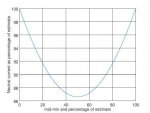msuchoff
Member
- Location
- Chapel Hill, NC 27516
You can determine neutral current in unbalanced 3-phase wye in your head and estimate's accuracy is pretty good.
This works for loads with PF=1.
When the remaining phase leg current is zero or same as max phase leg, estimate is exactly same as measured.
Worst estimate is when remaining phase leg is 1/2 value of max - estimate is then 15% high.
Example:
I can give math proof if there is interest.
This works for loads with PF=1.
- Examine the phase currents and note the maximum and minimum legs. Minimum can be zero.
- Estimated neutral current = max - min.
When the remaining phase leg current is zero or same as max phase leg, estimate is exactly same as measured.
Worst estimate is when remaining phase leg is 1/2 value of max - estimate is then 15% high.
Example:
- Phase leg currents are 40A, 50A, 55A.
- Max = 55A, min = 40A
- Estimate = max-min = 15A
- Measured neutral = 13.23A
- Estimate's accuracy = +12%
I can give math proof if there is interest.


